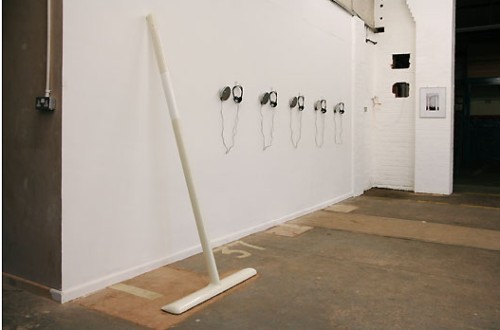Spaces From the Exhibition Gagarin’s Things
In 1999 I was invited to the USA for an artist’s residency in San Francisco of several months. Following one of the presentation lectures I was introduced to John Cole. He was interested in my work relating to the concept of social design and my cooperation with institutions and big manufacturing companies. He offered me an opportunity to take part in a project at NASA. He gave me a few days to think it over and proposed a meeting, where I would receive more information on the project in question if I was interested. I was very surprised by this offer and at the same time I was so taken by its unusual nature and fascinated that I agreed to the meeting.
Gagarin’s Thing, display case no.1 – archive photographs and documents relating to GT in the territory of the Soviet Union.
After a few days I received a folder with the inscription “Gagarin’s Thing” and an offer to collaborate on the restoration and subsequent artistic reconstruction of the object. The origin of Gagarin’s Thing was explained to me, as was the reason for its present lamentable state. John explained to me what had occurred in Prague in 1968 and therefore why I might be enthusiastic about the entire issue.
View of the GT exhibition, period posters
In the following years I had an opportunity to participate in the restoration of the destroyed object in the developmental laboratories of NASA and the Getty Institute, although my participation in this respect was more of a consultancy nature. Even though I was not allowed to work physically with the original object, I had a chance to see it many times in very close proximity. The work itself was fascinating, especially the part relating to material expertise and the subsequent application of fixation materials (details are given in the restoration report).

Gagarin’s Things, showcase no. 1 – archival photographs and documents relating to GT in the territory of the Soviet Union.
My main task, however, consisted in conducting a reconstruction of Gagarin’s Thing. I was to create a special, life-size model, which, and this was especially fascinating, was to reflect the appearance of Gagarin’s Thing in 1962. The reconstruction was to imitate Gagarin’s Thing in the condition in which it had been before it first arrived at the White House, i.e. before its definitive destruction.
Gagarin’s Thing, display case no.2 – archive photographs and documents relating to GT in the territories of the USA, Czechoslovakia and Cuba.
Gagarin’s Thing, display case no.3 – archive photographs and documents relating to GT in the territory of the Soviet Union.
Gagarin’s Thing, CD players with a 45 min. audio recording interpreting the history of GT and its influence on current affairs and political connections.
In the foreground, a model of GT reconstruction without an “energy source”.
Installation of walkmans and an audio lecture about GV and an audio guide to the exhibition.
Installation with reconstruction of a possible GT energy source, diagrams and descriptions of the artifact.
Aerodynamic Cable
This object was inspired by the knowledge gained by the study of the “Gagarin Thing”. The findings relate to the field of electro aerodynamics – a science which examines the movement of solid objects inside the electric current. This object illustrates not only the laws that govern the inside of such cables, where an intensive electron flow can be found, but also, most importantly, the relation of these dynamic processes to the extreme flow of energy in its surroundings.










